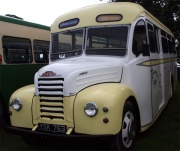Fordson: Buses: Difference between revisions
New page: ''Note: This is a sub-section of Fordson.'' * Ford commercials were renamed Fordson after 1933. * Redbourn Group bought a number of bodies in 1935. They controlled operations... |
No edit summary |
||
| Line 1: | Line 1: | ||
[[image:Im20100829Sh-Fo-YSK763.jpg|thumb| 1950. Fordson ET6. Reg No: YSK 763. ]] | |||
''Note: This is a sub-section of [[Fordson]].'' | ''Note: This is a sub-section of [[Fordson]].'' | ||
| Line 28: | Line 30: | ||
* The ''Transit'' is still available today. It has front suspension and many electronic engine controls. | * The ''Transit'' is still available today. It has front suspension and many electronic engine controls. | ||
== See Also == | |||
<what-links-here/> | |||
== Sources of Information == | |||
<references/> | |||
Latest revision as of 11:05, 10 September 2010

Note: This is a sub-section of Fordson.
- Redbourn Group bought a number of bodies in 1935. They controlled operations in Thanet Kent.
- East Kent took over the company later in 1935 and disposed of Fords.
- Two survived after this for a further 20 years by other owners.
- 1963 Ford introduced a 36ft two-axle chassis called the Thames 36.
- 1965 Thames 36 was replaced by the R-series. It had an increased power output.
- The National Bus Company was a big customer of the R-series.
- 1973 The A chassis was launched. It had a short bonnet and was designed for gross vehicle weights.
- 1974 Ford introduced a semi-automatic control for their six-speed synchromesh gearbox.
- 1977 The engine was modified and was inclined 45 degrees. This helped to reduce the noise of the vehicle.
- 1984 Devon General put a number of transits into operation in Exeter; the purpose - to replace the larger buses.
- Ford transits were used on nearly every public bus route.
- 1986 VE6 model was introduced.
- The Transit is still available today. It has front suspension and many electronic engine controls.

